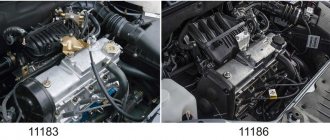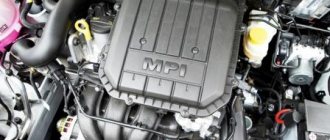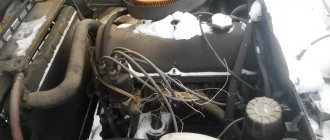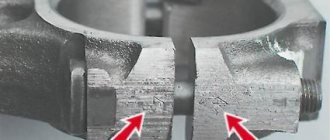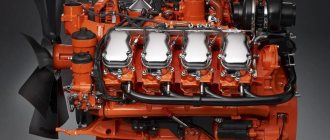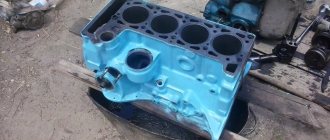I propose to discuss the new eight-valve engine with the VAZ-21116 index - this is a deep modernization of the 1.6-liter engine (VAZ-21114). When buying a car, I heard a lot about the upgraded engine from Granta (the norm). I knew that some kind of lightweight piston group was installed. Winter has come :), I have more time and decided to learn more about the engine. I am pleased with everything that the designers have done with the modernization of the engine, and the fact that the H-intake module has been improved, the pistons have been lightened, the collector has become quieter, and the timing belt tensioner has become automatic. Everything is great except the big one BUT
, which constantly keeps you in suspense.
When the timing belt breaks, the valves bend
and lead to expensive repairs. I’m not used to thinking positively about the domestic engine industry. The manufacturer promised that the timing belt will last 200,000 km, which is hard to believe. And the coolant pump has been improved. I don’t believe that it won’t require replacement no sooner than the car has run 180,000 km. As a rule, a pump malfunction provokes a break in the timing belt. The day before yesterday, a neighbor complained that the timing belt on his car (VAZ-2114) had broken. Work for an hour, replaced with a new one and back on the road. This won't work on Grant anymore. It is necessary to constantly inspect the condition of the timing belt and the condition of the coolant pump. It is well written about the engine HERE: www.zr.ru/a/422396/ cooling system: www.vwts.ru/cooling/cooling_syst_el_regul_rus.pdf
What is your opinion?
This engine on cars of the first years of production had the index 21116, later, without significant technical changes, it received the index 11186, maintaining all its indicators. According to some information, the change in the index is associated with a change in the supplier of the connecting rod and piston group; if in engine 21116 the supplier was Federal Mogul, then in the engine with index 11186 AvtoVAZ independently mastered the production of ShPG.
Engine 21116 is another representative of the power units produced for the Lada Granta. It is considered one of the best representatives of the AvtoVAZ production family. Production of the power unit began in 2011 and continues.
Specifications and description
The VAZ 21116 engine is a direct successor to the Kalinovsky engine 11186, modernized and improved. But, the main base of the engine belongs to the legendary Zhigulevsky engine - VAZ 21083.
So, let's look at the main technical characteristics of the 21116 motor:
| Name | Characteristic |
| Brand | 21116 |
| Marking | 1.6 (1596 cm cube) |
| Power | 87 horsepower |
| Type | Injection |
| Fuel | Petrol |
| Valve mechanism | 8 valve |
| Number of cylinders | 4 |
| Fuel consumption | 7.2 liters |
| Piston diameter | 82 mm |
| Resource | 200 - 250 thousand km |
Characteristics of motor 21116
The factory boost of the internal combustion engine was carried out without boring the cylinders or changing the piston stroke length, so the engine layout remained unchanged, it was equipped with standard parts that were already in production at the time of the project.
Block 21116
The technical characteristics of 21116 look like this:
| Manufacturer | AvtoVAZ |
| Engine brand | 21116 |
| Years of production | 2011 – … |
| Volume | 1597 cm3 (1.6 l) |
| Power | 66 kW (90 hp) |
| Torque moment | 143 Nm (at 3500 rpm) |
| Weight | 112 kg |
| Compression ratio | 10,5 |
| Nutrition | injector |
| Motor type | in-line |
| Injection | distributed electronically controlled |
| Ignition | modular type |
| Number of cylinders | 4 |
| Location of the first cylinder | TVE |
| Number of valves on each cylinder | 2 |
| Cylinder head material | aluminum alloy |
| Intake manifold | extended channels, flange for electronic damper |
| An exhaust manifold | catalyst |
| Camshaft | with toothed pulley |
| Cylinder block material | cast iron |
| Cylinder diameter | 82 mm |
| Pistons | original, produced by Federal Mogul |
| Crankshaft | from 11183 |
| Piston stroke | 75.6 mm |
| Fuel | AI-95 |
| Environmental standards | Euro-3 |
| Fuel consumption | highway – 5.7 l/100 km combined cycle 7.2 l/100 km city – 8.5 l/100 km |
| Oil consumption | maximum 0.5 l/1000 km |
| What kind of oil to pour into the engine by viscosity | 5W-30 and 10W-30 |
| Which engine oil is best by manufacturer | Liqui Moly, LukOil, Rosneft, Mannol, Castrol, Mobil, Shell |
| Oil for 21116 according to composition | synthetics, semi-synthetics |
| Engine oil volume | 3.5 l |
| Operating temperature | 95° |
| Motor life | declared 200,000 km actual 300,000 km |
| Adjustment of valves | washers between camshaft cams and tappets |
| Cooling system | forced, antifreeze |
| Coolant quantity | 7.8 l |
| water pump | TZA with plastic impeller |
| Spark plugs for 3S FE | BPR6ES from NGK or domestic A17DVRM |
| Gap between spark plug electrodes | 1.1 mm |
| Timing belt | Gates, width 22 mm, service life 200,000 km |
| Cylinder operating order | 1-3-4-2 |
| Air filter | Nitto, Knecht, Fram, WIX, Hengst |
| Oil filter | catalog number 90915-10001 replacement 90915-10003, with check valve |
| Flywheel | from 2110 |
| Flywheel mounting bolts | box MT – M10x1.25 mm, length 26 mm, groove 11 mm box AT – M10x1.25 mm, length 26 mm without groove |
| Valve stem seals | code 90913-02090 inlet light code 90913-02088 exhaust dark |
| Compression | from 14 bar, difference in adjacent cylinders maximum 1 bar |
| XX speed | 800 – 850 min-1 |
| Tightening force of threaded connections | spark plug – 31 – 39 Nm flywheel – 62 – 87 Nm clutch bolt – 19 – 30 Nm bearing cap – 68 – 84 Nm (main) and 43 – 53 (rod) cylinder head – three stages 20 Nm, 69 – 85 Nm + 90° + 90° |
A detailed description of the parameters is contained in the motor maintenance and repair manual.
Service
Maintenance 21116, typical for cars produced by AvtoVAZ. The main maintenance operations are changing the oil and oil filter. To change the lubricant, 3.2 liters of engine oil is required. In turn, 3.5 liters of lubricant fits into the engine.
It is recommended to fill in semi-synthetic motor oils marked 5W-30, 5W-40, 10W-40, 15W40.
The maintenance map looks like this:
TO-1: Oil change, oil filter replacement. Carry out after the first 1000-1500 km. This stage is also called the break-in stage, since the engine elements are grinding in.
TO-2: The second maintenance is carried out after 10,000 km. So, the engine oil and filter are changed again, as well as the air filter element. At this stage, the pressure on the engine is also measured and the valves are adjusted.
TO-3: At this stage, which is performed after 20,000 km, the standard procedure for changing the oil, replacing the fuel filter, as well as diagnosing all engine systems is carried out.
TO-4: The fourth maintenance is perhaps the simplest. After 30,000 km, only the oil and oil filter element are changed.
TO-5: The fifth maintenance is like a second wind for the engine. This time a lot of things are changing. So, let's look at which elements need to be replaced in the fifth maintenance:
- Change of oil.
- Replacing the oil filter.
- Replacing the air filter.
- Replacing the fuel filter element.
- The timing belt and roller are replaced.
- Alternator belt if necessary.
- Water pump.
- Valve cover gasket.
- Other items that need to be replaced.
- Valve adjustment, which adjusts the gas distribution mechanism.
Subsequent maintenance is carried out according to the 2-5 maintenance map for the corresponding mileage.
Maintenance
According to the manufacturer's requirements, engine 21116 must be serviced at the following intervals:
| Maintenance object | Time, year or km mileage, whichever comes first |
| Timing belt | 100000 |
| Battery | 1/20000 |
| Valve clearance | 2/20000 |
| Crankcase ventilation | 2/20000 |
| Belts that drive attachments | 10/200000 |
| Fuel line and tank cap | 2/40000 |
| Motor oil | 1/10000 |
| Oil filter | 1/10000 |
| Air filter | 1 – 2/40000 |
| Fuel filter | 4/40000 |
| Heating/Cooling Fittings and Hoses | 2/40000 |
| Coolant | 2/40000 |
| Oxygen sensor | 100000 |
| Spark plug | 1 – 2/20000 |
| Exhaust manifold | 1 |
Initially, the design included the simplest possible internal combustion engine device for independent power tuning and overhaul on its own.
Malfunctions and repairs
ICE 21116 is based on the 21114 power unit. Unlike its older brother, the piston group is produced by Federal Mogul, which made it possible to lighten the ShPG by 39%. If the timing belt breaks, the valve must bend. These are perhaps serious shortcomings. If the valves are bent, then a major overhaul of the cylinder head is guaranteed.
Frequent malfunctions of 21116 are tripping, and poor starting is due to poor quality of the ignition system and the formation of an air-fuel mixture that does not burn completely.
But these malfunctions are typical for all AvtoVAZ representatives. In this case, the car may still be under warranty service.
1_no_copyright
The modernization of the eight-valve VAZ-21114 engine was brought closer by two major events: the release of Grants to the market and the transition of the entire model range to the next environmental level - Euro-4. And although the old 1.6-liter, despite its advanced age (its roots stretch back to the mid-80s of the last century), did not look like a frail old man, new standards and trends required extensive changes. At the same time, the possibilities for maneuver for motorists, as often happens, were narrowed by financial limits.
Therefore, we went along the already beaten path. After all, several years earlier, a 16-valve engine of the same volume (VAZ-21126) underwent an update, on which some technical solutions were tested. Moreover, they were able to unify not only the approach, but also many details, for example, a connecting rod with liners, a piston pin and rings. The cylinder block, although with its own index, is exactly like that of the VAZ-21126 engine: with additional nozzles for cooling the pistons with oil and plate-honing of the cylinder walls, which reduces the break-in time.
However, it was not possible to copy all the changes exactly: organizing the workflow in an engine with two valves per cylinder is more difficult. Moreover, the requirements for the modernized eight-valve engine turned out to be stricter. Take, for example, the resource - 160 thousand km for the VAZ-21126 and 200 thousand km for the VAZ-21116. Photos with captions will tell you what was changed and why.
H
The new H-intake module was tested on an intermediate version - the VAZ-11183-50 engine (with a Euro-4 catalytic converter, but with a heavy connecting rod and piston group). Even without relief, only by optimizing the intake and exhaust it was possible to improve the main characteristics.
The modernized unit received longer channels, which made it possible to increase the torque, approaching the performance of a sixteen-valve valve. At the same time, in the VAZ-21116 its peak was reached 700–800 rpm lower. Another important feature: an electromechanical throttle module (commonly called “e-gas”) is now installed at the input to the receiver, and wires, rather than a cable, are stretched from the accelerator pedal to the engine. Thus, the control unit was able to fully control the supply of not only gasoline, but also air to the cylinders. This is for the benefit not only of the environment, but also of safety, because many electronic assistants (their list on VAZ models will soon be replenished) keep the car on its trajectory, including by dosing traction.
Dynamics
External view of engine 21116
This is not a racing car, but there is enough power for both city driving and highway driving. If we compare it with the 16-valve engine of the Lada Granta, which is installed on the Luxury versions, then it has more torque at the bottom. This means that you can drive in 5th gear at a speed of 40 km/h.
For example, you are driving at 5 speed, the traffic light in front lights up red. You release the gas pedal and the car brakes with the engine. The light turns green and you can continue driving in 5th gear even if the vehicle speed has dropped to 40 km/h.
I was pleasantly surprised by the elasticity of the motor. Considering that I previously owned a Priora, and it has a 98 hp engine, then the engine is 87 hp. I like grants better.
What cars was it used in?
The 21116 engine was created for all car models produced at that time:
- Lada Kalina-2 – station wagon, hatchback and sedan;
- Lada Priora – sedan, station wagon and hatchback;
- Lada Granta – sedan and liftback.
Lada Priora
Improved engine characteristics provide a potential of 120 hp. With. without critical wear or 180 l. With. with loss of resource.
Engine Features
Due to the design of the car's cooling system, the engine does not warm up above 80 degrees. The management of AvtoVAZ does not see anything wrong with this; they have an official information letter on this matter. You can read it in the material: What is the operating temperature of an 8 valve engine.
The engine design is as simple as an axe. There are no hydraulic compensators, no sores were noticed. Mostly problems can arise due to malfunctions in the engine management system.
Video of acceleration to 100 km per hour
I haven’t shot my video yet, it’s winter, so we’ll wait for the weather to warm up. That's when I'll post it on our YouTube channel. In the meantime, here's a video from Grantovodov.
Here's another interesting video. It is interesting because the measurement is made using an application with a navigator , which means that the speedometer readings are more accurate if the navigator is well calibrated. Everyone knows that the higher the speed, the more the car’s speedometer lies.
8 valve engines
Unlike 16 valves, a single-shaft gas distribution system is used here. There are two valves for each cylinder: intake and exhaust. Such engines are reliable and do not bend valves when the timing belt breaks, but are significantly inferior in the dynamic performance of the vehicle, as well as in the noise level of the internal combustion engine.
Engine VAZ 11183
This engine was installed not only on Grants, but also on the last 2114 years of production. The engine is quite noisy and requires frequent valve adjustment due to the lack of hydraulic compensators. 183 the engine does not bend the valve when the timing belt breaks. This is the only engine installed on the Grant that is not afraid of timing belt breakage.
Technical characteristics of VAZ 11183:
| Fuel supply | Injector |
| Number of cylinders | 4 |
| Number of valves | 8 |
| Compression ratio | 10 |
| Power (hp) | 82 |
| Engine capacity (cc. cm) | 1596 |
| Required fuel | Not lower than AI 95 |
| Torque (N*m) | 120 |
Engine VAZ 11186
This engine is installed in the last years of Granta production. It significantly reduced the noise characteristics and increased the compression ratio, which led to the meeting of the valves with the pistons when the timing belt breaks. Increasing the compression ratio made it possible to achieve more power from the internal combustion engine, which was beneficial for the dynamic characteristics.
Technical characteristics of VAZ 11186:
| Fuel supply | Injector |
| Number of cylinders | 4 |
| Number of valves | 8 |
| Compression ratio | 10,5 |
| Power (hp) | 90 |
| Engine capacity (cc. cm) | 1596 |
| Required fuel | Not lower than AI 95 |
| Torque (N*m) | 143 |
Noise level
I switched to this car from the Renault Megane 2. My Renault was equipped with a 1.6-liter engine, a power of 113 horses, and the number of valves was 16.
After it, the Granta engine works like a tractor. Regardless of the car's mileage. Even the engine on the carburetor VAZ-21093 seemed quieter to me.
I specifically compared the noise level on a new Grant with a mileage of 5,000 km and on mine with a mileage of 55,000 km. As it warms up, the sound becomes quieter, but most likely you just get used to it.
But it is also worth considering that there are no hydraulic compensators, so you will have to adjust the valves. By the way, the engine in the luxury version (98 hp) also rumbles.
Engine tuning Lada Granta, VAZ 21116, VAZ 11186
Atmospheric tuning of the Grant engine
Let's consider the potential of the 21116 8V engine without replacing the cylinder head with a 16 valve (The 126 16V engine and its modifications are mentioned in a separate article). The first stage, already familiar to us from tuning the 21114 engine, is replacing the camshaft with a Nuzhdin 10.93, installing a split gear, and adjusting the phases. We hang a receiver on top, a 54 mm damper and a 4-2-1 spider exhaust with this kit the engine power will be about 100 hp. With additional modifications and milling of the cylinder head, as well as the intake manifold, we will get about 120 hp.
Compressor for Lada Granta
Another method of obtaining similar output from a 116 engine is to install a PK-23-1 compressor with a pressure of 0.5 bar on the piston drain. With a need shaft of 10.63 or 10.42 the result will be better. The well-known video clearly explains everything that is required for the successful implementation of a project based on 2113; all this can be easily recreated on Grant, Kalina, Priora and other cars.
Engine life
Under the hood in the “Norma” configuration
The question that causes the most controversy. Officials talk about a mileage of 150,000 km before major repairs; some have traveled 200 thousand km or more without problems. I have a friend who already had his engine repaired at 40 thousand km because the timing belt broke. Yes, the engine here is “plug-in” - this means that if the timing belt breaks, the pistons meet the valves and you can see the fist of friendship.
Engine resource 87 hp. 21116 according to the passport - 150,000 km!
Studying the forums, based on my own experience, I can say that it all depends on how you will operate the engine. The most banal thing: the quality of the oil (choose correctly) and engine operating modes - this is what the mileage before you need to do major repairs depends on.
Malfunctions: causes, elimination
In addition to the fact that in the event of a sudden break of the timing belt, the motor 21116 bends the valve with pistons, the following characteristic problems are observed:
| Uncertain engine operation | burnt valves, decreased compression | replacing valves, rings |
| Increase in coolant temperature | pump or thermostat failure | Repair of parts or replacement of the entire unit |
| Loss of power, interruptions in operation | spark plug failure, high-voltage wire breakage | replacing spark plugs and wires |
| The engine stalls | incorrect valve clearance settings | adjustment after 15 - 30 thousand km |
The internal combustion engine modification 21116 is considered a fairly reliable power drive. Does not cause serious problems if maintenance regulations are followed.
Reviews from car owners about the 87 hp engine.
Most reviews are positive.
Mostly problems occur due to low-quality fuel and lubricants. The engine may start to stall and run intermittently (floating idle, stalls, loss of power, etc.). In this case, the “Check Engine” malfunction icon (indicator) should light up on the instrument panel.
The engine pulls well at low end; on the highway, even with a full load, there is enough power. This is especially noticeable when compared with a Ford Focus automatic: engine capacity 1.6, power 100 horsepower. Granta drives more fun, Focus “deflates” after 80 km per hour. As for Focus - personal experience, I owned just such a car.
Fuel consumption
Even in a mixed cycle with traffic jams, consumption will not exceed 10 liters per hundred!
Fuel consumption is good. Even in a mixed cycle with traffic jams, consumption will not exceed 10 liters per hundred. My consumption is 8 liters in the city, 6 on the highway. This is on 92 gasoline. I checked from tank to tank, it roughly matches the readings of the on-board computer. On 95 gasoline, which is what AvtoVAZ recommends using, fuel consumption should become even less.
If your consumption exceeds the norm, then you need to look for a malfunction. Do not delay troubleshooting, as your engine may be overloaded.
Starting in the cold
In cold weather it starts, even after a long stay. The main thing is a good battery, a working fuel pump and power system.


